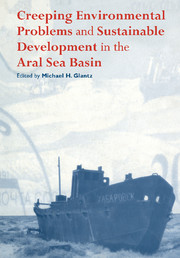Book contents
- Frontmatter
- Contents
- List of contributors
- Introduction
- 1 Sustainable development and creeping environmental problems in the Aral Sea region
- 2 Ecological disaster linked to landscape composition changes in the Aral Sea basin
- 3 Alteration of water level and salinity of the Aral Sea
- 4 Desertification in the Aral Sea region
- 5 Climate fluctuations and change in the Aral Sea basin within the last 50 years
- 6 Priaralye ecosystems and creeping environmental changes in the Aral Sea
- 7 Public health in the Aral Sea coastal region and the dynamics of changes in the ecological situation
- 8 The impact of political ideology on creeping environmental changes in the Aral Sea basin
- 9 Change of the rivers' flow in the Aral Sea basin (in connection with the problem of quantitative assessment and consideration of environmental after-effects)
- 10 Fish population as an ecosystem component and economic object in the Aral Sea basin
- 11 Creeping environmental changes in the Karakum Canal's zone of impact
- 12 Environmental changes in the Uzbek part of the Aral Sea basin
- 13 Creeping changes in biological communities in the Aral Sea
- Index
12 - Environmental changes in the Uzbek part of the Aral Sea basin
Published online by Cambridge University Press: 19 October 2009
- Frontmatter
- Contents
- List of contributors
- Introduction
- 1 Sustainable development and creeping environmental problems in the Aral Sea region
- 2 Ecological disaster linked to landscape composition changes in the Aral Sea basin
- 3 Alteration of water level and salinity of the Aral Sea
- 4 Desertification in the Aral Sea region
- 5 Climate fluctuations and change in the Aral Sea basin within the last 50 years
- 6 Priaralye ecosystems and creeping environmental changes in the Aral Sea
- 7 Public health in the Aral Sea coastal region and the dynamics of changes in the ecological situation
- 8 The impact of political ideology on creeping environmental changes in the Aral Sea basin
- 9 Change of the rivers' flow in the Aral Sea basin (in connection with the problem of quantitative assessment and consideration of environmental after-effects)
- 10 Fish population as an ecosystem component and economic object in the Aral Sea basin
- 11 Creeping environmental changes in the Karakum Canal's zone of impact
- 12 Environmental changes in the Uzbek part of the Aral Sea basin
- 13 Creeping changes in biological communities in the Aral Sea
- Index
Summary
The environmental safety of a nation is determined by its environmental philosophy or a concise statement summarizing the set of official views and principles worked out by political leaders, a declaration of primary goals, trends, and ways a nation's activities can achieve an optimal interaction between society and nature.
To harmonize the interactions between society and nature it is essential to create conditions for environmental stability manifested as the ability of the ecosystems to sustain their structural and functional features under direct and indirect stress of anthropogenic impacts. Environmental problems that emerged in the Aral Sea basin are an integral part of the socio-economic policy pursued in the former USSR.They cannot be solved isolated from other acute issues facing society.
Creeping environmental phenomena in the Aral Sea basin have resulted from:
orienting agriculture and industry toward maintaining the cotton independence of the former USSR at the cost of large-scale development of new (virgin) lands without improving the quality of those lands;
widespread introduction of cotton and rice monocrops;
large-scale non-dose-related ‘chemicalization’ of agriculture;
use of water-wasting technologies and irrigation techniques resulting in enormous losses of irrigation water during its transport;
irrational siting of production activities in locations with a deficit of water resources and without regard to air pollution.
These factors emerged under the then-dominant socio-economic and political conditions of the former Soviet Union, which can be characterized by the following factors:
centralized command-and-control-type administration of the national economy based on state ownership of the means of production and natural resources with an absence of economic responsibility (i.e., penalties) for environmental damage;
[…]
- Type
- Chapter
- Information
- Publisher: Cambridge University PressPrint publication year: 1999



